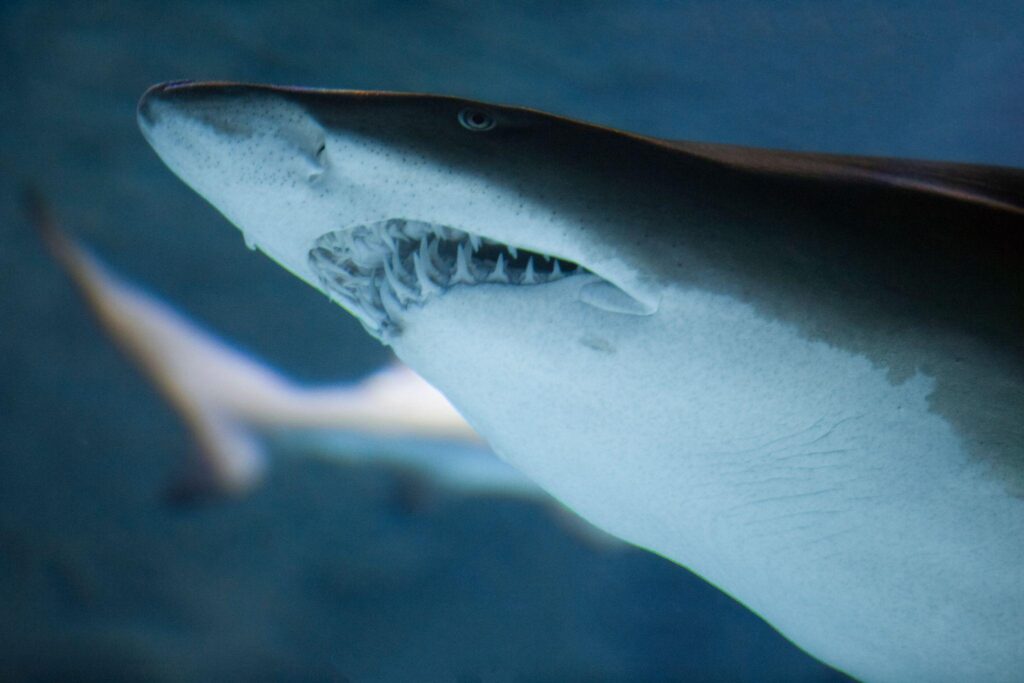Let’s have some fun discussing facts about animal mouths! Animal mouths vary greatly, even among those in the same categories. Not all fish have the same type of teeth; not every cat possesses saber teeth, and even elephant “teeth” can vary, depending on their species. Animals don’t just use their teeth for eating. They move their little ones with their mouths, groom themselves, defend themselves from those who want to snack on them, and some even use their mouths to build their homes!
We’ll learn some fun facts about animal teeth and how every animal has the teeth that work best for them. There are so many interesting facts you won’t believe what we’ll uncover!
Water Animals
Let’s start with the animals we see in the water. Whether in the ocean, lakes, or streams, animals use their mouths to eat and ward off predators.
Sharks
Of course, we have to begin with sharks! The first thing that comes to mind when you think of a shark is their teeth, right?

Did you know that most sharks are born with a complete set of teeth? Sharks lose a tooth about once a week. They constantly shed their teeth because they have no roots like we do. Another tooth comes forward within a day!
Many sharks have 15 rows of teeth at times and may grow 20,000 or more in a lifetime. The Bull Shark has up to 50 rows of teeth! It is considered the most dangerous of all sharks; you wouldn’t want to look one in the face and argue that point!
Sharks do not usually develop tooth decay. They have natural fluoride covering their teeth, which makes them resistant to dental caries. Also, sharks don’t show their upper teeth when swimming around. When they want to take a bite out of something, the upper jaw of some sharks can unhinge from their skull, and their teeth move forward to chomp down. Shark teeth are razor sharp and sometimes serrated, so they bite and tear their prey apart before swallowing it.

In an interesting twist, many types of sharks have a symbiotic relationship with a small fish called remoras. Rather than being eaten by the shark, remoras will attach to a shark to hitch a free ride and be protected from other predators. They also get to eat scraps of prey that the shark drops and will eat parasites off the shark’s skin. This helps sharks stay healthier and protects them from being irritated by the parasites!
Alligators and Crocodiles
Although the alligator and crocodile body shapes are similar, they do not have the same kinds of teeth.

Alligators have more blunt adult teeth, so they must snap their jaws very hard to bite down. If they lose one tooth, another replaces it! Alligators can produce up to 3,000 teeth in their lifetime.
Alligators have so many teeth that they have 74-84 in their mouths at once! Now, that’s a mouthful!
A crocodile’s teeth are pretty different than alligator teeth. A crocodile has very sharp teeth and uses them to tear apart their prey and swallow large chunks. They may have between 60-110 teeth at once! New teeth replace the old up to 50 times, and they may have 4,000 different teeth in their entire lifespan!
Some other interesting facts about crocodiles: they don’t sweat. Instead, they open their mouths wide and pant like dogs to cool off. While their mouths are open, the Nile Crocodiles sometimes get a visit from their busy neighborhood Plover bird. This small bird sits in the crocodile’s mouth, picking meat particles from between its teeth. Just think if your oral hygiene regimen included letting a small bird pick your teeth! What a way to clean those pearly whites!
Whales
Now, let’s talk about whales. Did you know there are two kinds of whales in the animal kingdom? One type has teeth, called toothed whales, and the other does not. Whales without teeth are called baleen whales.
A blue whale, the largest animal on earth, is one example of an “untoothed” or baleen whale. They have baleen plates that move the food they eat down their throats in a “slinky” motion. The plates are like brooms that capture what they eat, and the water flows out of the sides of the mouth.

The blue whale is the largest animal. However, it only eats tiny shrimp, krill, and other small animals like plankton. They gather food by opening their giant mouths and swallowing their food whole.
Orcas, sometimes called “killer whales,” have very sharp teeth that tear into the flesh of their prey and jerk smaller pieces free to eat. These whales are an example of a “toothed whale.”

The orca eats fish, seals, and smaller whales like the beluga. The orca’s diet is dictated by its location and the other fish and marine life available.
Now, let’s return to land to talk about other fun facts about animal teeth!!
Jungle Animals

Clouded Leopard Kitten
The Clouded Leopard has a beautiful face and the longest pair of upper canines relative to its body size, measuring up to 2 inches long. Its jaws can open to almost 90 degrees, whereas most large cats can only open to about 65 degrees.
The Clouded leopard eats a wide variety of small and medium-sized animals. This cat’s teeth grab their prey from behind the neck instead of at the front. They adapt to the forest and jungle, where they can move around well on their shortened legs.
Elephants
When you look at an elephant, there are so many interesting features you don’t know where to start being amazed! Large flapping ears, the unique flexible trunk that acts like a hand, and their teeth…er…tusks!
Tusks are what we see outside an elephant’s mouth. They are actually teeth, and more specifically, they are incisors! Both male and female African elephants have tusks, but only the male Asian elephants have large tusks. Female Asian elephants have very small tusks or none at all.

An elephant is born with four teeth developing on each side of the jaw. Two are visible, and two are still below the gums. The tusks they are born with are called milk teeth, and they fall out around one year of age. After they fall out, they get their permanent tusks, which don’t protrude beyond the elephant’s lips until they are two to three years old. As they age, elephants have six molars on each side of their upper and lower jaws (permanent teeth), which never stop growing, but the rate slows down.
Elephant tusks will continue to grow about nine inches per year. Not unlike humans, elephants’ tusks and teeth within the mouth have pulp with dentin covering it, and the ”root” goes about one-fourth of the way down into the socket.
An elephant uses its tusks to dig, defend against enemies, and show off to other elephants. Just as humans are right or left-handed, the elephant is right or left-tusked. The shortest tusk is usually the dominant side or “master” tusk, which is used more and wears down the quickest.
Summing Up the Grrr-ific Fun Animal Mouth Facts
These are just some interesting facts about animals and their mouths and teeth. There are so many others in the animal kingdom who have their own fun facts. Whether on land or in the water, animals have interesting teeth!
Some are large, some are small, and some of the biggest have no teeth at all. Hey, that rhymes!
Humans don’t have the Plover bird to clean our teeth and gums. However, it is best to see our dental staff at Jungle Roots for a much safer and sanitary visit with our dental hygienist and dentist every six months. We hope to see you soon!
